I hope you enjoy this blog post. If you want Hello Bar to grow your leads, click here.
Author:
Michael Wicker
Published
June 13, 2024
I hope you enjoy this blog post. If you want Hello Bar to grow your leads, click here.
Author:
Michael Wicker
Published
June 13, 2024
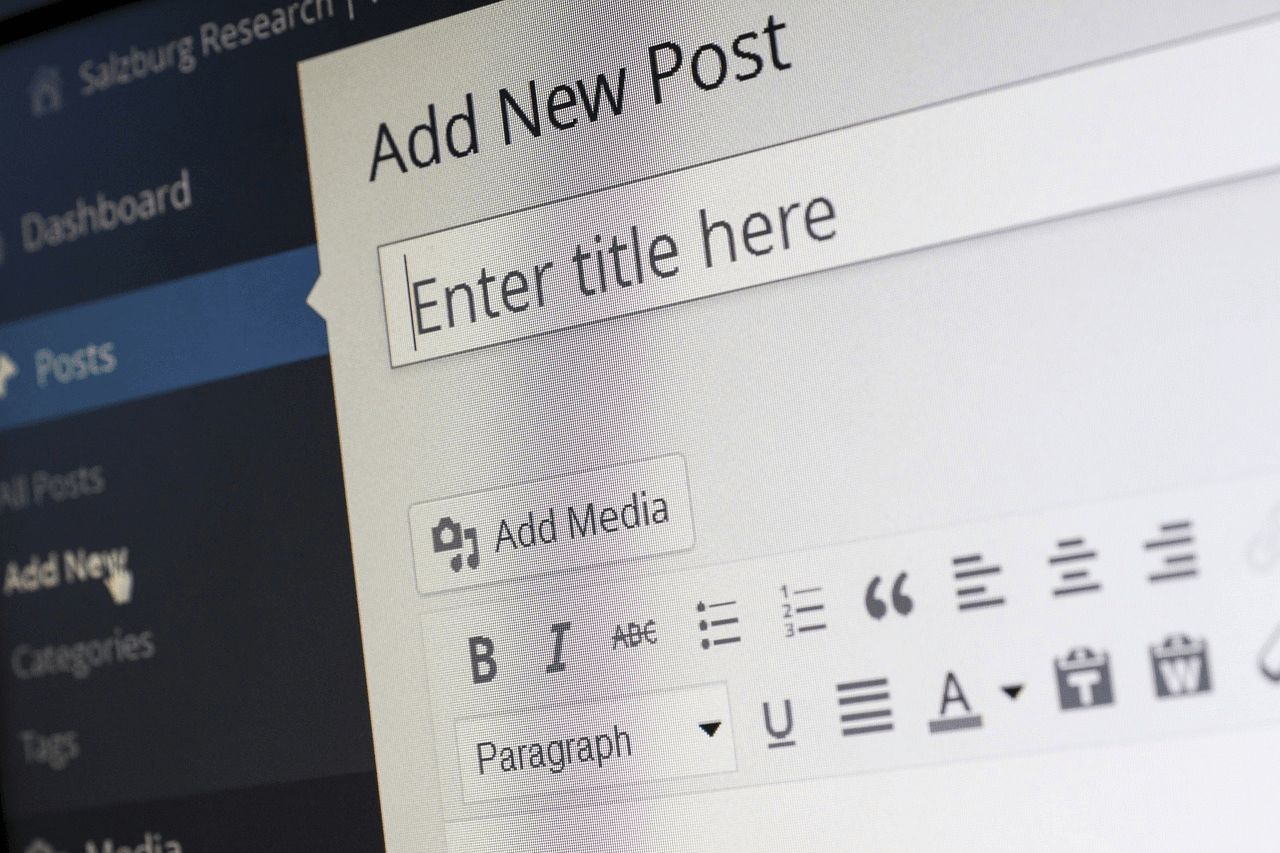
Be it a story, an advertisement, an article, or a video, they all are incomplete without a headline. It serves as the first point of contact with the audience, aiming to grab attention while summarizing the following content.
These days, headlines serve a greater purpose than just being the introductory line. They are a crucial element of any marketing strategy. This holds true whether you’re launching a blog, a podcast, or an email campaign.
In this article, we’ll explore practical headline writing tips and best practices. We also delve into success metrics and popular formulas to help you craft compelling headlines.
Let’s get started.

A headline serves as the title or initial text of content, offering an extremely specific and concise summary. It is an integral part of a newspaper article, blog post, ad, social media post, video, or even an email.
A headline serves essential functions in several contexts:
Essentially, a headline is a gateway to your content. It appears in search results, links, social shares, and beyond.

If you struggle to apply techniques for writing great headlines, you’re not alone. Many times, the right headline doesn’t come to me right away.
However, we also use tools to help grab the readers’ attention. Hello Bar, for instance, allows you to maximize the visual impact of a given headline.
Exit popups and regular Hello Bars both help drive more traffic through your website. Convince people to visit other pages and therefore remain on your site for longer periods of time.
For instance, you can make your Hello Bar whatever size you wish. Sometimes, bigger really is better because it grabs your readers’ attention.
Consider A/B testing different sizes, and let Hello Bar calculate the results of the test for you.
It’s important to consider several factors before you even start to write a headline, which means it might take some effort. Following are a few headline writing tips to consider.
The more you know about your audience, the more effective your headlines become. Do they like listicles (articles based on a list of items, tips, strategies, etc.)? Q&As? Tutorials?
Review the web traffic to all blog posts you’ve written in the last six months. Look for patterns. You might find, for instance, that you get the most clicks when your headline is front-loaded with a number or statistic.
Headlines perform best when they convey a personal benefit to the reader. In other words, what can the reader take away from the rest of the content?
This is why listicles work so well:
In each of these examples, the benefit and the takeaway are present in the title.
Acronyms might seem cheesy, but they work — not least of all because they’re easy to remember.
The 4 U’s of writing effective headlines are pretty simple:
Make sure nobody else has used a headline like yours. Not only will you struggle to compete in the SERPs, but if someone has already read your competition’s article, they probably won’t click on yours.
It’s easy to craft a unique headline if you know the content that already exists. Run Google searches for permutations of your primary keyword. When you write your own headline, make sure it doesn’t look similar to those in the search engine results pages.
Consider using unique words, too. They shouldn’t be too obscure — you want to get your message across — but consider using a word that wouldn’t normally be paired with the content you’ve created.
One of the best headline writing tips for writing headlines is to drill down on your topic as tightly as possible. It’s kind of like narrowing your niche. You want to let the reader know exactly what he or she will get.
Consider these two headlines:
The second one is far more specific, right? It tells the reader what will be delivered and narrows down the subject matter to show that it isn’t going to contain fluff and filler.
Don’t be afraid of using extra words. If you keep your headline to about 77 characters or fewer, you’ll do fine.
This sounds obvious, but if you scan many of the headlines on some of today’s blogs, you’ll see that it isn’t. Many creatives get a little too creative with their headlines — and confuse their readers in the process.
Furthermore, every piece of content you write should have a specific purpose. It needs to tell a story, provide value, and allow your reader to accomplish something, whether it’s reaching a goal or solving a problem.
Urgency is a marketer’s best friend. If you can convince your reader that he or she needs to act now, you’ll have done your job well.
Time-bound headlines can work well, but only for a short period of time. For instance, Black Friday articles often pop up in droves in the weeks leading up to Thanksgiving. Articles like these enjoy only seasonal popularity.
However, you can incorporate urgency into the article’s goal. Check out a few examples:
These headlines entice clicks because the reader wants to know what he or she is missing.

Now that we’ve covered some of the basic headline writing tips, let’s dive into the good stuff. Learning new techniques for writing headlines can help you become a better writer all around.
For instance, you can use these same strategies on your subheadings and even in your body copy. They can help keep your readers moving through the piece until the very end, which improves metrics like time on page.
Following are 18 effective headline writing tips and techniques for writing unique and attractive headlines.
Believe it or not, words can be classified as strong or weak. The difference depends on the impact the word has on the reader.
Study the headlines of the articles you enjoy most. What words did the author include in the headline? And in what order?
You’ll start to pick out patterns in the best headlines. They use strong verbs that convey action, motion, and achievement. They also eliminate stop words (words like of, for, nor, a, the, etc.) unless they’re necessary for the headline to make sense.
CoSchedule’s blog post title demonstrates the effectiveness of this strategy. Notice how adding “That Will Get You Inspired” makes it more compelling.

Image via CoSchedule
This headline reassures readers that there’s light at the end of the tunnel.
There’s no reason to put your creativity on a leash when you’re writing headlines. In fact, one of the best headline writing tips is to let your creativity flourish.
Feel free to make a bold or controversial statement. Maybe your opinion differs from the other movers and shakers in your industry. Don’t be afraid to take a stand.
You can also use the negative approach to garner clicks. For instance, I could have changed this title to the following: Why You’re Not Writing Good Headlines.” In other words, tell your readers what they’re doing wrong — and how to fix it.
The HOTH, a digital marketing company, loves to use this trick in their blog posts. Check out the example below:

Image via The HOTH
It piques your curiosity, right? That’s because it challenges the norm, making you eager to see their perspective.
“How Many Headlines Can You Write in an Hour?”
That’s a great headline for an article on this kind of topic. It gets the creative juices flowing not just for the reader, but also for the writer.
“Why Do Your Headlines Suck So Much?”
That’s another one that incorporates a dollop of humor. Just make sure you don’t offend your audience if you employ sarcasm or wit as part of your headline.
Our next choice in this list of headline writing tips is too simple to believe. Adjectives are meant to clarify the noun in a headline or sentence. They can also add color and interest.
Let’s look at one of our headline examples from above: “17 Runners’ Tips You’ve Been Missing Out On”
How can we spiff this up and make it more compelling for readers.
I might change it to this: “17 No-Nonsense Runners’ Tips You’ve Been Missing Out On”
It suggests that the article will be filled with valuable, actionable material. I could trade out that adjective for many others:
Each of these adjectives help clarify the noun “tips” for the reader.
Superlatives (words indicating the best, highest, greatest, etc.) can make or break your headline. If you use them when they’re not applicable, you’ll generate more eye rolls than clicks. However, if you can back up your statement, go forth and use superlatives.
YouTuber Joshua Weissman loves to grab attention with bold headlines.
For example, check out his video titled “The Easiest Chocolate Cake of All Time.” This clever title speaks to home bakers’ struggles and is sure to boost views.
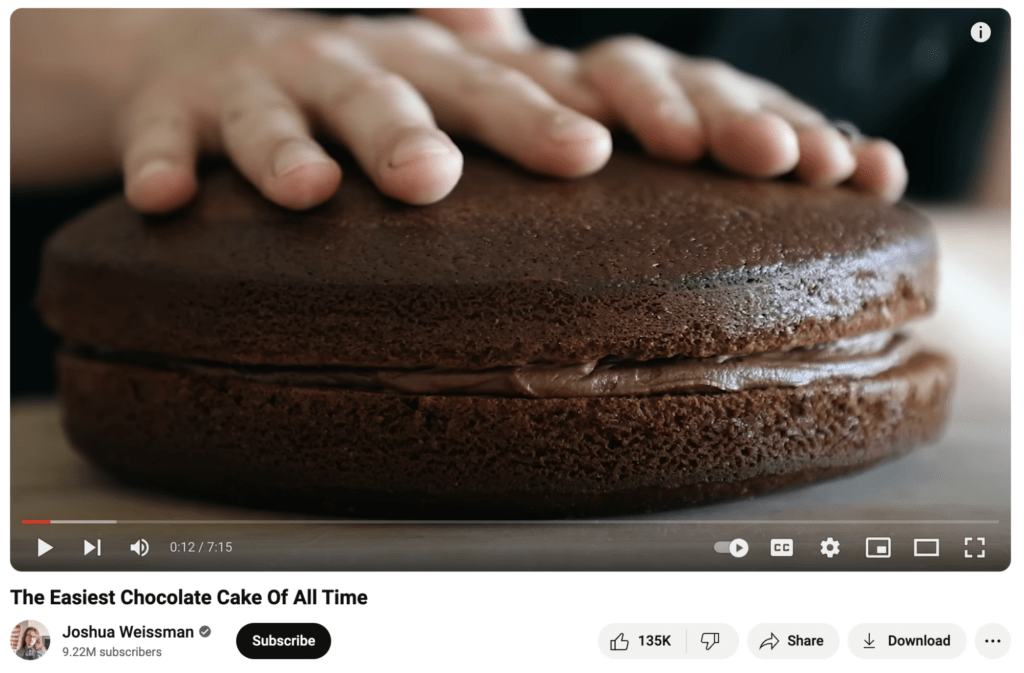
Image via YouTube
Writers — especially newbies — sometimes produce verbose copy. That’s fine, but when you’ve finished your first draft, go through and pare down the verbiage.
Let’s look at two examples of passages I might write for our fictional article about marathon running:
In these examples, we have a wordy passage (number one) and a more concise one (number two). I edited 33 words down to 22.
How? For the most part, I removed unnecessary phrases. “In order to” becomes merely “To.” I didn’t need to say “a minimum of” and “at least” because they say the same thing. I removed unnecessary words and rephrased to make the second sentence clearer.
This is never more true than when you’re crafting your headline. An overlong or wordy headline will either confuse or irritate your readers. They might not even understand what you’re trying to communicate.
Urgency is our next pick in this list of helpful headline writing tips. It’s like a magic wand you wave in front of your audience. When executed correctly, urgency leaves readers with no choice but to click.
Such clickbait headlines can come in many forms, such as the following:
It works best for an article that can help your reader accomplish something faster. You’re offering shortcuts, workarounds, or better strategies.
In the last example, I’m teasing a revelation. People who don’t click right now won’t get to learn my secrets.
Here’s another gem from a YouTuber sharing valuable tips on running online businesses. The headline promises quick money-making tips. Who wouldn’t want that, right?

Image via YouTube
BuzzFeed does this really well. The publication has recently featured headlines like these:
The headlines work because they inspire curiosity. The content itself might not be life-changing, but the headline gets the click.
You can do the same with more serious pieces by asking an evocative question:
Did you ever watch the HBO television series “True Blood”? When vampire Bill Compton tells Sookie the name of the vampire bar in Shreveport — Fangtasia — she does an eye roll.
Compton replies, “You have to remember that most vampires are very old. Puns used to be the highest form of humor.”
Far be it for me to disagree with a fictional vampire, but puns are still funny. And they still work in headlines.
If you can write headlines that incorporate a play on words, you’ll incite immediate curiosity.
Yes, punctuation matters! It sounds silly, but it can drive reader interest. It might also help with SEO.
You’ll notice that the headline for this article uses a colon. You could also replace it with a hyphen or em-dash to get the same effect.
Let’s look at three headlines:
There’s nothing inherently wrong with the last headline. However, it won’t grab the reader as quickly.
We focus on the first part of a headline. So do search engines like Google. If you can get the primary keyword at the beginning of the headline, you have a better chance for clicks and better rankings.
Essentially, hyphens and colons allow you to break up your headline into two parts. You can communicate more information that way and arrange your headline for both reader interest and SEO.
A rationale is simply an inducement to click. It gives the reader an excuse to see what the article has to offer.
You find rationale words in many listicles and tutorials. Some of the most common include the following:
While puns and adjectives can make headlines more clickable, you don’t want to go overboard. When in doubt, go by one of the best headline writing tips: keep it short, sweet, and simple.
In other words, communicate a benefit to the reader and the reason you’re writing the article. That’s it. If it takes 10 words, that’s fine. If it only takes four words, that’s fine, too.
Take a look at the headline in HelpGuide.org’s blog post. It’s incredibly straightforward yet effectively conveys the article’s topic.
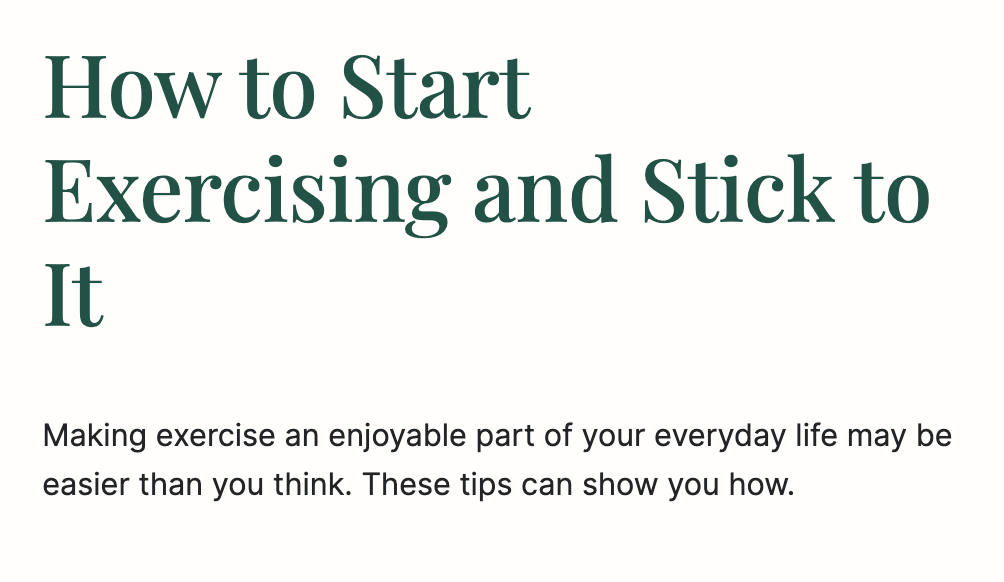
Image via HelpGuide.org
This clarity not only reduces confusion but also amps up engagement.
You’ve heard of personalized marketing, right? It’s a way to make every communication with your followers feel like it’s meant just for them.
You might include your subscribers’ first names in your mass emails to them, for example. Your email sounds less like a marketing message and more like a missive from a friend.
For instance, if you’re educating people about marathon running, a catchy email subject line could look like one of these:
The second one is more inviting, right? It’s more casual, and it sounds like it’s written just for the recipient.
However, you don’t need first names to personalize a headline. Just use the word “you.” Even though it’s meant for public consumption, it sends the subtle message that it’s for that particular reader alone.
This approach is evergreen and shines in various contexts. Take a look at this example from HuffPost’s personal essays section.

Image via HuffPost
Don’t you think the headline does an exceptional job of directly addressing the reader?
Numbers are kind of like magic for headlines. They automatically attract attention.
My business partner, Neil Patel, recently published an article about how much he’s spending on YouTube ads:
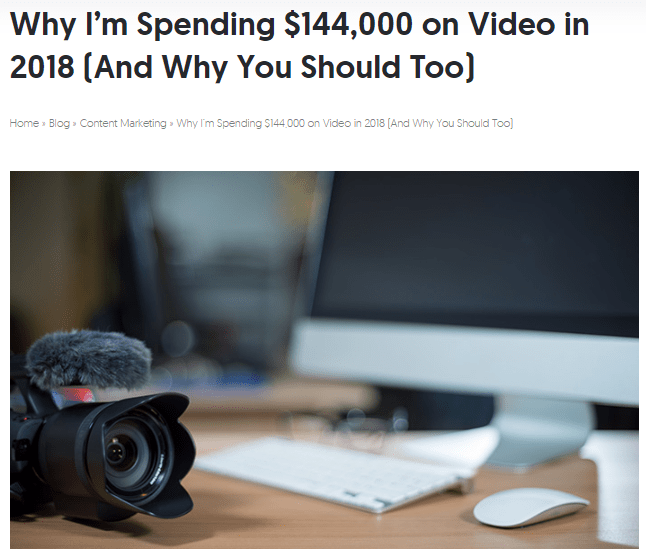
That’s a big number, right? It catches your attention right away.
Statistics can serve the same purpose. For instance, if you have the data, you could write an article with one of these headlines:
Making your readers feel a deep emotion in just a few words is tough, but it can be done. It’s much easier if you’re writing about an emotive topic.
For instance, let’s say you want to write about runners’ safety out on the road. You could write an article about wearing safety gear, using reflective badges, and other tips.
Your headline can seal the deal: “Runners, You Don’t Have to Get Run Over. Read On to Protect Yourself.”
It sparks emotion. Nobody wants to get run over during a run. They also want to protect their friends and family members who run.
Don’t forget about title length limits on different platforms!
Each platform has its own rules. Make sure your titles fit within the specified character counts.
But note that there’s a difference between character limits and optimal limits.
For example, YouTube caps titles at 100 characters. That said, anything over 70 gets snipped with those pesky ellipses.
Email subject lines should ideally stay under 50 characters. Similarly, Google search result titles fare best between 55-60 characters.
Sticking within these boundaries ensures your titles pop with visibility and engage your audience. Use a title generation tool for social media to make sure you don’t exceed character limits.
Our headline writing tips are not just about how to write them but also about finding the right assistance. We understand the ongoing discussions about AI tools, especially in content creation.
Yet, when wielded with finesse, they can truly streamline your headline-generation process.
AI-powered headline generator tools can assist you:
And guess what? There’s a treasure trove of AI tools worth using.
For example, Ahrefs provides a free AI title generator for blog articles. Similarly, MonsterInsights offers a tool for headline analysis:
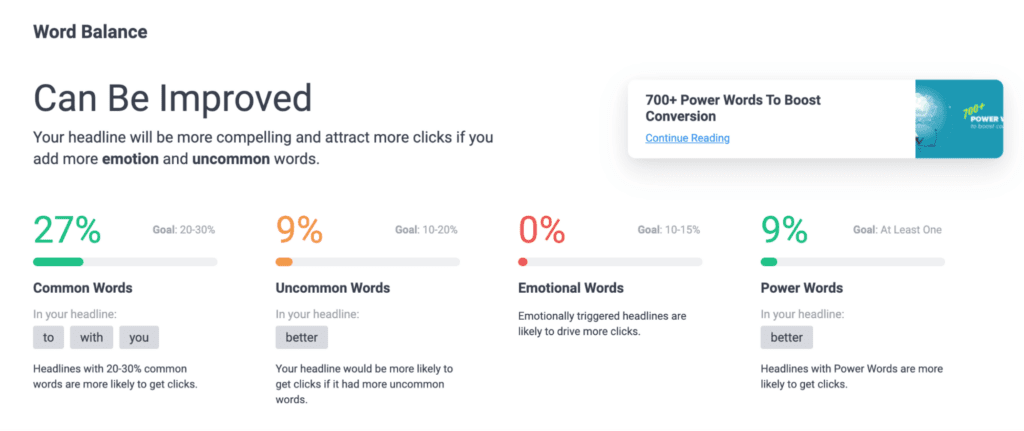
Image via MonsterInsights
One of the obvious yet easily ignored headline writing tips is effective testing. You could speculate as to what headlines will perform best. You could conduct competitor analyses, use AI tools, and maximize your creativity.
However, the only true test of gauging efficacy is by testing it. Here are some ways to do this:
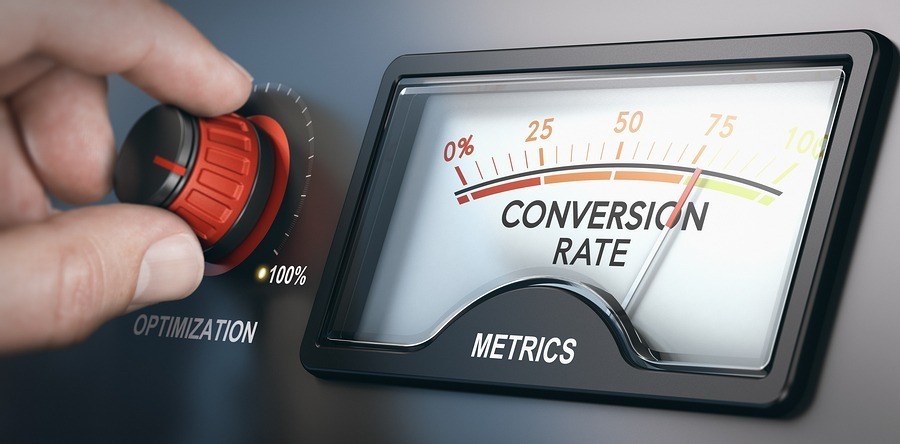
When it comes to headlines, the same formulas or strategies won’t work on every audience. You have to figure out what your specific readership responds to best.
Maybe a list post appeals to your audience. Deliver what they want to read.
But first, you have to examine the data. Along with the headline writing tips, monitor these crucial metrics to ensure the success of your headlines.
Click-through rate measures the ratio of clicks on a specific link to the number of times it’s shown. It’s a top-notch metric for gauging headline effectiveness.
When your headline gets lots of clicks, you know you’re doing something right. But if not, it’s time to shake things up.
Measuring CTR works wonders regardless of the type of content you’re crafting.
A good headline will be catchy and compelling enough to engage the reader.
Here are some more metrics to help gauge your headline’s performance:
Dwell time clocks how long visitors linger on your website after clicking through from a headline.
It’s like a digital hourglass, measuring the allure of your content.
A longer dwell time signals content success. It indicates that visitors are captivated and exploring further. Conversely, a shorter dwell time may hint that your headline could have hit the mark better.
Users commonly share content solely based on powerful headlines. This is often due to time constraints.
A compelling headline may be enough to assure them of the value it offers to others.
It could generate numerous likes and shares across social platforms. These include Facebook, Twitter, Instagram, YouTube, and others.
Likewise, in email, this could translate to metrics like the volume of email forwards.
Again, these metrics are primarily focused on gauging overall content performance. That said, they also double as reliable indicators of headline effectiveness.
Great headlines can also promote conversation. You might get comments on your blog posts or social media about the articles you’re writing, the products you sell, or the services you offer. Track these interactions to see if they correlate to certain headline types.

I’m not a huge fan of the word “formula,” so I’m using it loosely. When I think of a formula, I imagine a process or recipe that must be followed to the letter.
Headline formulas are a little different You want to exert your creativity over the process.
SHINE is an acronym that boils down to these five words:
S – Specificity
H – Helpfulness
I – Immediacy
N – Newsworthiness
E – Entertainment value
You don’t have to pack all five of these qualities into every headline. However, if you can hit at least one or two notes, your headline will probably perform better.
This is one of the best techniques for writing headlines because it allows for plenty of creativity.
Let’s build one from our marathon runner example article:
“Sick of Sore Feet? Try These 12 Tips to Banish Aching Feet for Good”
Can you pick out each element?
You can use this formula for just about any headline or topic.
There’s one great way to immediate capture interest from your target audience. Introduce “little-known ways” to solve a problem or reach a goal.
The formula works because it suggests that the reader won’t have heard of the tips you’re going to suggest. Of course, you need to back up the headline with a slam-dunk article.
The Neil Patel homepage is the perfect example of the “who else wants” formula in action:
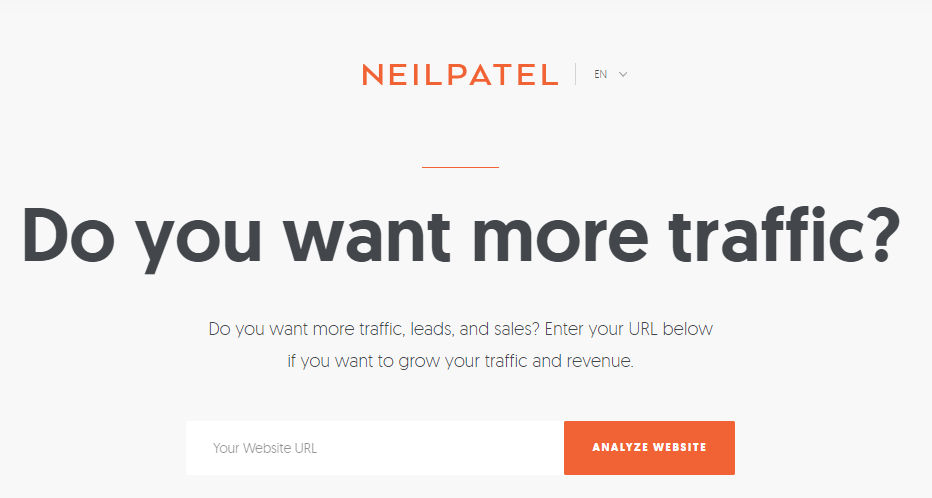
The headline asks, “Do you want more traffic?” It implies that Neil can deliver results for that goal if you follow through by entering your information.
You don’t have to use the exact verbiage “who else wants,” but you can:
This headline style is great for community building, too, because it encourages conversation.
We all have things we want to get rid of — telemarketing calls, inflated gas prices, bed bugs, whatever.
(To be clear, I don’t have bed bugs. There are no bed bugs in my home.)
The point here is that a “get rid of” headline promises a solution to the problem your audience faces. Think about what they might want to get rid of.
For my runner example, my audience might want to get rid of those stubborn last five pounds, calluses, shin splints, or leg cramps. If I can help them resolve the issue, I’ll have won a fan.
Q 1. How do you write a perfect headline?
A. To craft a perfect headline, start by understanding your audience’s needs.
Additionally, implement headline writing tips like the use of power words words and phrases that keep readers engaged. Ensure clarity and relevance to the content. Experiment with different styles and formats and analyze their performance.
Finally, refine your headlines based on search traffic and data.
Q 2. What is the 80/20 rule of headlines?
A. The 80/20 rule highlights that only 20% of readers typically proceed past the headline. The remaining 80% may not engage further.
Therefore, crafting killer headlines is crucial. It determines whether the majority of your audience will delve into the rest of your content.
Q 3. What is the formula for writing a headline?
A. Headline formulas serve as templates for writing great headlines. They break down the structure of a headline into specific elements. This way, you have a roadmap to craft engaging headlines consistently.
Below are some popular headline formulas:
Q 4. What is a direct headline?
A. A direct headline is concise and straightforward. It conveys the main benefit or message of the content without any fluff.
Such headlines aim to grab the reader’s attention quickly. They’re often used in advertisements and marketing materials.
Q 5. What is a headline structure?
The structure of a headline generally follows these key components:
The best headline writing tips and techniques help you connect with your audience. They evoke an emotional or automatic response to the subject matter.
However, you need a tactical approach.
Try each of these techniques for writing headlines, then come back and tell me which one(s) worked best for you. Don’t forget to carefully study your favorite headlines, apply the four U’s, get to know your audience, and offer personal benefits.
If one headline structure doesn’t work, try another. You can always re-engineer content that doesn’t meet your expectations.
Do you have a favorite headline formula? Share it with the class!